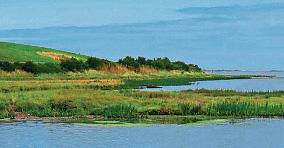POSTCARD FROM KENT

Though I was born 10 years after the end of World War Two, I have an enduring childhood memory of clambering around a disused air raid shelter. It was reached, after negotiating clumps of stinging nettles, in an area we called the dump, near where we lived. Inside, it was pitch black and cavernous, with several underground chambers. My intrepid pals and I would explore without the benefit of a light - not even a match.
These days, it would be securely cordoned off, but not then.
Those memories came flooding back when I took a tour of one of the largest public wartime shelters in the country. I'm not referring to a bunker in a city centre but a network of caves in deepest Kent. Chislehurst Caves (020 8467 3264, chislehurst-caves. co.uk) were quickly (and unofficially) used as a shelter when the bombing of London started in 1940. Soon, people thronged there by the thousands each evening. The caverns grew into an underground city of sorts.
I joined one of the regular guided tours. Our small group was shown bunk beds of the sort used by sheltering families. Areas set up as a chapel, canteen, first aid station, lavatories - even a bank, post office and dentist surgery - were pointed out by our guide, Darren. Most of the vast labyrinth is unlit, so we were handed paraffin-burning hurricane lamps. Their flickering flames cast strange shadows on the walls, some of which are decorated with elaborate carvings.
The caves aren't a natural feature but entirely man-made. Technically, they are mines as they were hacked out of the ground by Romans, Saxons and their successors. Men dug for chalk and flint. During World War One, the space provided a ready-made ammunition depot.
Later, in the 1920s and 30s, the caves housed a mushroom farm and rhubarb grew well, too. I could feel the temperature dropping as we trekked deeper into the void. We could see our breath.
この記事は Best of British の November 2024 版に掲載されています。
7 日間の Magzter GOLD 無料トライアルを開始して、何千もの厳選されたプレミアム ストーリー、9,500 以上の雑誌や新聞にアクセスしてください。
すでに購読者です ? サインイン
この記事は Best of British の November 2024 版に掲載されています。
7 日間の Magzter GOLD 無料トライアルを開始して、何千もの厳選されたプレミアム ストーリー、9,500 以上の雑誌や新聞にアクセスしてください。
すでに購読者です? サインイン

Grand Designs
Sandra Blemster looks at how the work of William Morris continues to resonate

POSTCARD FROM NORFOLK
With his Austin Cambridge long consigned to the great garage in the sky, Bob Barton enjoys a scenic journey by bus through Nelson's County

The Serious Side of Ken Dodd
Philip Williams and David Williams look back on the comedian's prolific and fruitful recording career

The Sport of Kings (and Queens)
Michael Montagu looks back on the history of Royal Ascot and Henley Royal Regatta

The Sound of Silver
Barry Collings on the rediscovery of the rare single Lost Summer Love

The Need for Steed
Chris Hallam remembers The Avengers star Patrick Macnee

Stairway to Success
Chris Hallam celebrates the acting and writing talents of Upstairs, Downstairs co-creator Jean Marsh

Question time
Send us your questions and we'll track down the answers

DOON THE CLUB
John Stoker recounts the perils faced by comedians in the working men’s clubs of the north-east

THE CHARITY THAT BEGAN WITH HOMES
William Sutton’s legacy founded The Sutton Trust. David E Norris recounts its groundbreaking work
